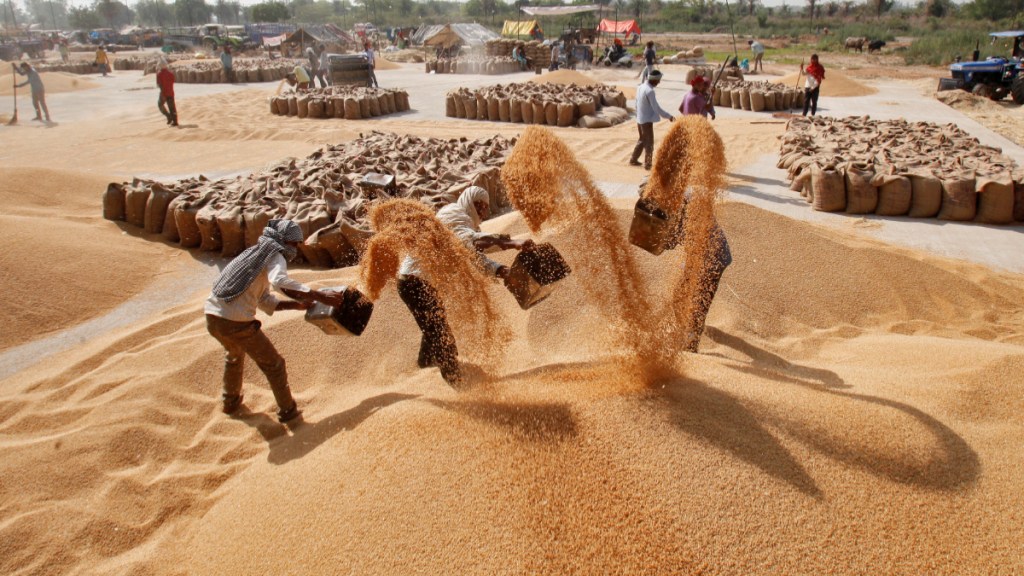Ashok KK Meena & Chandrasen Kumar
Food prices in general, and that of wheat in particular, rose sharply because of disruptions caused due to the pandemic coupled with the start of the Russia-Ukraine conflict as two countries account for a quarter of the world’s wheat supply. But India not only warded off distress among its poor citizens due to food scarcity, it also managed to control the spike in wheat prices.
Though 2022 retail inflation in India remained higher than RBI’s upper target bound of 6% till about September—with a peak of 7.8% in April—India was much better placed compared to many developed economies that had to face double-digit inflation coupled with economic slowdown. India’s total cereal production increased from 285.28 million tonnes (mt) in 2021-22 to 288.03 mt in 2022-23, even when wheat production declined marginally from 109.59 mt to 106.84 mt.
Sensing an opportunity for profit via export of wheat, private traders purchased substantial quantity during the rabi marketing season of 2022-23. Total purchase by government agencies was only 18.8 mt against the normal average procurement of 35mt. Later, due to the prospect of a lower domestic supply, the Centre banned the export of wheat on May 13, 2022, but by then, about 5 mt of wheat had already been exported.
Much before the World Bank advised nations, in June last year, on taking proactive steps to control spikes in food prices, the Centre had already taken a pragmatic policy decision in the form of Pradhan Mantri Garib Kalyan Ann Yojna (PMGKAY), giving additional 5 kg free food grains to about 813 million covered under the National Food Security Act (NFSA). About 112 mt of additional food grains, allocated at an estimated cost of Rs 3.9 trillion from April 2020 to December 2022, were delivered through the supply network of the Food Corporation of India (FCI) and allied agencies. This made almost every needy family completely secure in terms of foodgrains and kept basic food inflation under control.
Though the retail inflation had come down during October and November 2022, it bounced back in December 2022 and showed an upward trend in January this year. One major source was steep rise in prices of wheat and wheat flour/products. Wheat prices generally rise from December to March because, unlike rice, it is harvested and sold by farmers only during the rabi marketing season within a window of about three and a half months from mid-March to June. But the rise in wheat prices this year has been phenomenal. It could be attributed to excessive profit expectations by private traders as they had procured substantial quantity due to prospects of exporting wheat at higher international prices, but had to hold it due to the ban on wheat exports.
Concerned over the sharp rise of wheat- and wheat-product-prices, the Centre decided to intervene in the open market by releasing 3 mt wheat from central pool stocks, which has been increased to 5 mt as on February 21, 2023. Market intervention in case of a steep price rise is one of the mandates of FCI. The open sale of wheat by FCI is called Open Market Sales Scheme (Domestic), or OMSS(D). To control the rising prices without hurting any stakeholder, the policy design has two main strategies—to ward off hoarding of purchased wheat from open sale by large traders and to send an appropriate signal to market players that the wheat purchased under open sale must be made available to domestic consumers immediately.
Thus, the open sale has been made competitive through the e-auction platform (m-junction) with a reserve price. The quantity of wheat to be purchased has been kept between 10-3,000 tonnes. To ensure competition, 300,000 tonnes of wheat has been reserved for institutional buyers, who can purchase wheat directly from FCI at reserve prices without participating in e-auction, subject to the rider that they will sell wheat products at a capped price. Besides, 200,000 tonnes have been reserved for state governments, which can take 10,000 tonnes of wheat for selling to consumers. A weekly auction is conducted for lifting/delivery from as many as 620 locations spread across 23 states in the country to a large number of small and medium traders and flour millers with an easy registration process. This process of e-auction shall continue till a new crop arrives.
As on March 5, 2023, FCI has already conducted four e-auctions and sold 2.34 mt to more than 1,100 registered bidders. About 1.8 mt of wheat has already reached the market. Reserve prices have fallen to Rs 2,150/qtl and Rs 2,125/qtl for fair average quality (FAQ) and under relaxed specifications (URS) quality wheat, respectively, so that the maximum benefit is passed on to consumers as soon as possible. As a result of the open sale, market prices of wheat and wheat flour have cooled down by 15% to 25% within four weeks. It is expected that retail prices of wheat all over the country should now remain within Rs 23-Rs 25/kg with a suitable profit margin. The success of PMGKAY and OMSS(D) for wheat in warding off a steep rise in wheat prices due to short supply is a good policy lesson for other countries of the world.
(Respectively, chairman & MD, and deputy general manager, Food Corporation of India. Views are personal)

